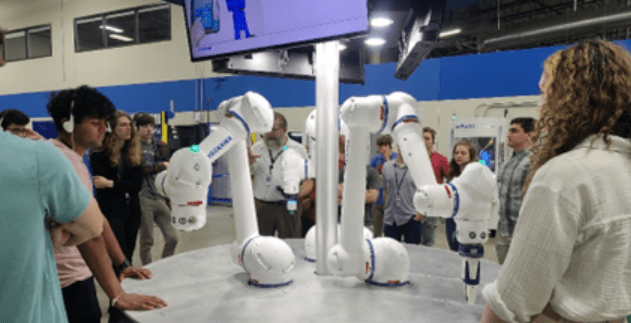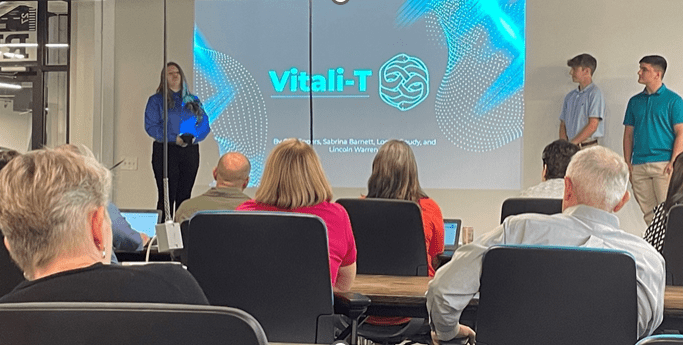
The experience also boosted both the competence and confidence of many participants, including Dylan Littrell, from the Greene County Career Center. “I got much better at making presentations,” he said after presenting his project, a helmet that would provide a 360-degree view and be able to identify hostile personnel. “I used to be super nervous. After this summer and rehearsing this so many times, I’m much more comfortable in front of an audience.”
The students, all area high-school students, were recruited and vetted by the Strategic Ohio Council for Higher Education (SOCHE), which pairs students at all academic levels with internships across multiple career pathways in government and industry. Cassie Barlow, SOCHE president, acted as one of nine judges who rated each team’s presentation in areas ranging from body language to marketing research. The top three teams were G.H.O.S.T., the aforementioned 360-degree helmet; Roller Panel, a flexible electric vehicle charging “blanket” powered by solar panels; and Vitali-T, a T-shirt with sensors that would provide immediate feedback on an array of health markers.
“I appreciate the innovative thinking all of you used in your projects,” said Barlow during the judging. “The work that you did across schools was impressive – it’s not very often we get to work with people we don’t see in the halls every day.”
“The polish of the presentations was very impressive,” said Steve Fennessey, Director of Innovation and Air Force/DoD Engagement. “It looked as if you rehearsed hundreds of times, and that is something you will definitely have to do in any career you choose. It’s a hugely valuable skillset.”
Each week, the students went on a field trip to an area business with roots in STEM, a learning and networking opportunity that even the youngest among them could appreciate.
In preparation for their tour, Yaskawa America Inc., a manufacturer of variable frequency drives, servo systems, machine controllers, and industrial robots, sent Clint Chapman, Senior Manager of Strategic Partner Relations, to talk to the students before they toured the company.
“I will go back to my offices confident about the future,” he said. “Kids today have really grown, and as the U.S. auto industry reshores, their maturity and education will be of huge benefit.”
The students were guided by a curriculum called FlexFactor, a STEM education program designed to familiarize K-12 students with advanced manufacturing technology, entrepreneurship, and education and career pathways. It was developed by NextFlex, a consortium of companies, academic institutions, non-profits and local, state and federal governments with a shared goal of advancing U.S. manufacturing of flexible hybrid electronics.
In the Dayton area, Sinclair Community College manages FlexFactor deployment. Julie Huckaba, FlexFactor project manager at Sinclair, said that when the program began in spring of 2021, just 13 students at Jefferson Township High School participated. So far this year, 630 students have been through the program, not including those who took part this summer.
“I don’t have solid numbers yet for this academic year because school just got under way, but it’s looking to be 300-plus for the fall,” she added. “I had to push another new school back to spring because I just don’t have enough bandwith!” An added incentive is the ability of the students to earn one college credit hour for successfully completing the program.
Ms. Huckaba agrees that it’s the public speaking and personal connection aspect of the FlexFactor-guided internship that makes the largest difference to the students.
“We do a survey at the end, and the area the students always find most valuable is in the area of public speaking,” she said. “Their presentations are excellent. They really do rise to the occasion.”

